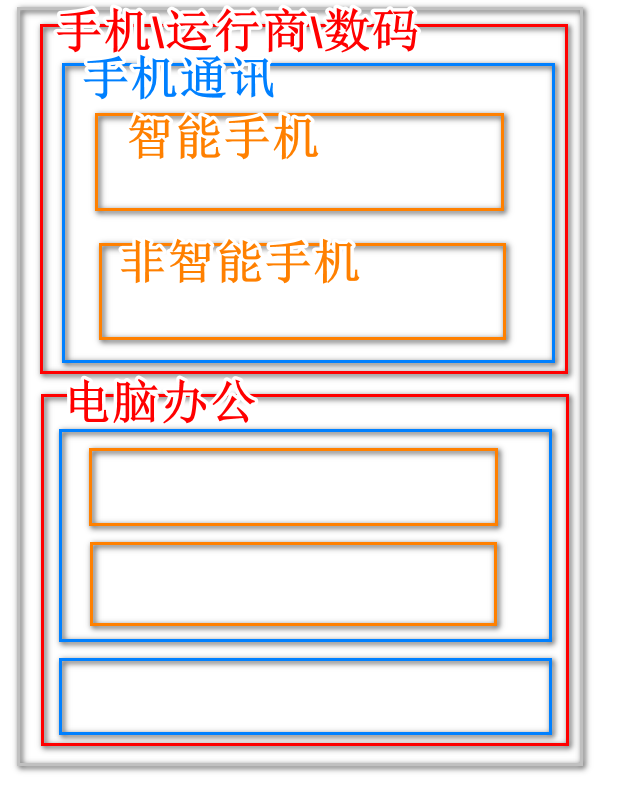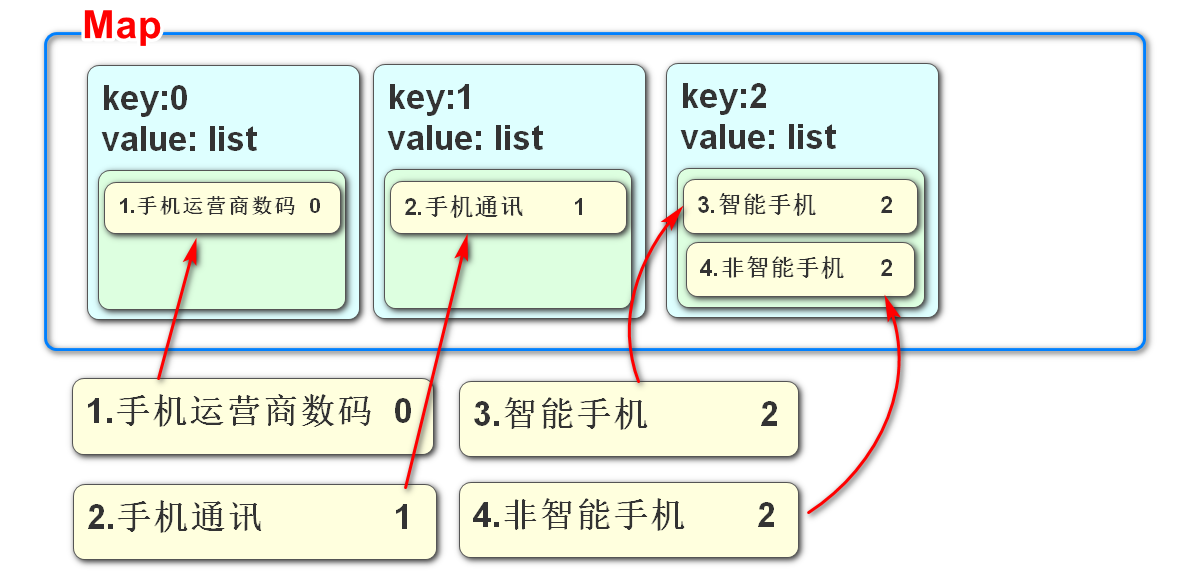分类功能实现逻辑
我们数据库mall_pms的category表使用自关联实现了三级分类
当前酷鲨商城项目使用固定的三级分类
1.从数据库中查询出所有分类信息,一次性全查
2.构建分类信息的父子结构,实现查询返回父子结构的分类信息
3.将查询到的结果保存在Redis中,以备后续用户直接获取
代码中要判断Redis中是否包含全部分类数据,不包含的话做上面操作
包含分类数据的话直接获得之后返回
业务分析
查询全部分类的业务重点在构建三级分类树结构
我们需要将从数据库中查询出的分类对象构成下面的结构
[
{id:1,name:"手机/运行商/数码",parentId:0,depth:1,children:[
{id:2,name:"手机通讯",parentId:1,depth:2,children:[
{id:3,name:"智能手机",parentId:2,depth:3,children:null},
{id:4,name:"非智能手机",parentId:2,depth:3,children:null}
]},
]},
{id:5,name:"电脑/办公",parentId:0,depth:1,children:[....]}
]上面是我们需要获得的对象的结构
可以理解为下图

在数据库mall_pms中
有pms_category表,这个表就是保存全部分类信息的表格
id:主键
name:显示在页面上的分类名称
parentId:父分类的id 如果是一级分类父分类id为0
depth:分类深度,当前项目就是3级分类,1\2\3 分别代表它的等级
keyword:搜索关键字
sort:排序依据 正常查询时,根据此列进行排序,数字越小越出现在前面(升序)
icon:图标地址
enable:是否可用
isparent:是否为父分类 0 假 1真
isdisplay:是否显示在导航栏 0不显示 1显示
实施开发
front:前台
在csmall-front-webapi项目中开发
无需编写持久层代码,因为mall_pms数据库的所有操作均在product模块编写完成了
我们front模块只需dubbo调用即可
创建service.impl包
包中编写业务逻辑层实现类FrontCategoryServiceImpl 实现IFrontCategoryService
// front模块要Dubbo调用product模块的方法,实现查询所有分类信息列表
@DubboReference
private IForFrontCategoryService dubboCategoryService;
// 方法要将查询到的信息保存到Redis,需要操作redis的对象
@Autowired
private RedisTemplate redisTemplate;
// 开发时,使用Redis要规范的定义一个常量用作key的名称,防止编码时拼写错误
public static final String CATEGORY_TREE_KEY="category_tree";
// 返回三级分类树对象的方法
@Override
public FrontCategoryTreeVO categoryTree() {
// 先检查Redis中是否已经保存了三级分类树对象
if(redisTemplate.hasKey(CATEGORY_TREE_KEY)){
// 如果Redis中有这个key,直接获取信息后返回
FrontCategoryTreeVO<FrontCategoryEntity> treeVO=
(FrontCategoryTreeVO<FrontCategoryEntity>)
redisTemplate.boundValueOps(CATEGORY_TREE_KEY).get();
// 别忘了返回
return treeVO;
}
// Redis中没有三级分类树信息,表示本次请求可能是首次访问
// 这就需要我们从数据库中获取三级分类树信息,在保存到Redis中
// 要dubbo调用product模块查询所有分类信息
List<CategoryStandardVO> categoryList =
dubboCategoryService.getCategoryList();
// 上面返回集合的泛型CategoryStandardVO是没有children属性的,而FrontCategoryEntity是有的!
// 因为转换过程比较复杂,所以最好单独声明一个方法来进行转换
// 目标是将子分类对象添加到对应的父分类对象的children属性中
FrontCategoryTreeVO<FrontCategoryEntity> treeVO=
initTree(categoryList);
// 上面方法完成了三级分类树的构建,返回了treeVO
// 下面要将treeVO保存到Redis,方便后续请求获取
redisTemplate.boundValueOps(CATEGORY_TREE_KEY).set(
treeVO,
1,
TimeUnit.MINUTES);
// 上面时间定义了1分钟,是适合学习中测试使用的,项目上线时,时间会长,例如24小时或更长
// 这样也要返回treeVO!!!
return treeVO;
}
private FrontCategoryTreeVO<FrontCategoryEntity> initTree(
List<CategoryStandardVO> categoryList) {
// 第一步
// 确定所有分类对象对应的父分类的id
// 创建一个Map
// 以父分类id为Key,将这个父分类包含的所有子分类对象保存在value中
// 这样就能实现第一步的目标
Map<Long,List<FrontCategoryEntity>> map=new HashMap<>();
log.info("准备构建三级分类树,分类对象数量为:{}",categoryList.size());
// 遍历数据库查询获取的所有分类对象集合
for(CategoryStandardVO categoryStandardVO : categoryList){
// 当前遍历的对象categoryStandardVO没有children属性,不能保存关联的子分类对象
// 所以我们先将它转换为能够保存子分类对象的FrontCategoryEntity类型
FrontCategoryEntity frontCategoryEntity=new FrontCategoryEntity();
// 同名属性赋值
BeanUtils.copyProperties(categoryStandardVO,frontCategoryEntity);
// 获取当前分类对象的父分类id,用于后续判断,如果父分类id为0,就是一级分类
Long parentId=frontCategoryEntity.getParentId();
// 判断map中是否已经存在这个父分类id作为key
if(!map.containsKey(parentId)){
// 如果map中没有这个key,表示当前父分类id作为key第一次出现,要新增一个元素
// 元素的key就是这个parentId,元素的值是个list
// 先实例化这个List
List<FrontCategoryEntity> value=new ArrayList<>();
// 将当前元素保存到集合中
value.add(frontCategoryEntity);
// 最后将key和value作为元素保存到map
map.put(parentId,value);
}else{
// 如果map中已经存在当前分类对象父分类id为key的元素
// 就将当前分类对象,直接添加到这个父分类id元素的value集合中
map.get(parentId).add(frontCategoryEntity);
}
}
// 第二步
// 构建三级分类树,将子分类对象添加到父分类对象的childrens属性中
// 先来获取所有一级分类对象,也就是父分类id为0的分类对象
List<FrontCategoryEntity> firstLevels=map.get(0L);
// 判断一级分类集合如果为null(或元素个数为0)直接抛出异常,终止程序
if(firstLevels==null || firstLevels.isEmpty()){
throw new CoolSharkServiceException(
ResponseCode.INTERNAL_SERVER_ERROR,"没有一级分类对象!");
}
// 遍历一级分类集合
for(FrontCategoryEntity oneLevel : firstLevels){
// 一级分类对象的id就是二级分类对象的父id
Long secondLevelParentId=oneLevel.getId(); // getId!!!!!!!!!!!!!
// 从map中根据secondLevelParentId获取这个对象包含的二级分类对象集合
List<FrontCategoryEntity> secondLevels=map.get(secondLevelParentId);
// 判断二级分类中是否有元素
if(secondLevels==null || secondLevels.isEmpty()){
// 二级分类对象集合缺失,不用抛异常,日志输出警告即可
log.warn("当前二级分类没有内容:{}",secondLevelParentId);
// 当前二级分类没有内容,无需运行循环中后面的语句,直接进行下次循环
continue;
}
// 二级分类集合有元素,开始遍历二级分类对象
for (FrontCategoryEntity twoLevel : secondLevels){
// 获取当前二级分类对象的id,作为三级分类的父id
Long thirdLevelParentId=twoLevel.getId(); // getId()!!!!!!!!
// 根据这个id获得这个二级分类对象关联的所有三级分类对象集合
List<FrontCategoryEntity> thirdLevels=map.get(thirdLevelParentId);
// 还是判断三级分类集合是否为空
if(thirdLevels==null || thirdLevels.isEmpty()){
log.warn("当前二级分类没有三级分类内容:{}",thirdLevelParentId);
continue;
}
// 将三级分类对象集合添加到当前二级分类对象的childrens属性中
twoLevel.setChildrens(thirdLevels);
}
// 在内层循环结束后,在外层循环结束前
// 将二级分类对象集合添加到当前一级分类对象的childrens属性中
oneLevel.setChildrens(secondLevels);
}
// 到此为止,我们所有的分类对象都已经保存在了自己对应的父分类对象的children属性中
// 现在就需要将firstLevels赋值给FrontCategoryTreeVO类型的categories属性中
// 实例化对象
FrontCategoryTreeVO<FrontCategoryEntity> treeVO=
new FrontCategoryTreeVO<>();
treeVO.setCategories(firstLevels);
// 最后千万别忘了返回treeVO!!!
return treeVO;
}
}
创建控制层
controller包
CategoryController类
代码如下
@RestController
@RequestMapping("/front/category")
@Api(tags = "前台分类查询")
public class CategoryController {
@Autowired
private IFrontCategoryService categoryService;
@GetMapping("/all")
@ApiOperation("查询获取三级分类树对象")
public JsonResult<FrontCategoryTreeVO<FrontCategoryEntity>> getTreeVO(){
FrontCategoryTreeVO<FrontCategoryEntity> treeVO=
categoryService.categoryTree();
return JsonResult.ok(treeVO);
}
}启动nacos\seata\redis
先启动生产者product\后启动消费者front
访问
localhost:10004/doc.html
Redis中不保存集合
原因
一方面是Redis保存对象比保存list效率高
另一方面,Redis保存集合容易出现冗余数据
假设数据库中有数据:1,2,3,4,5,6,7,8
但是如果Redis中允许随意保存集合,Redis中的保存可能出现下面情况
{1,3,5,6}
{3,4,6,7}
{1,5,7}
{2,5,8}
递归实现文章参考








 文章描述了一个电商项目中如何通过数据库查询构建三级分类树,并利用Redis进行缓存以提高效率。首先,从数据库获取所有分类信息,然后构建父子结构,保存到Redis。当Redis中不存在数据时,才执行数据库查询和构建过程。代码示例展示了如何使用Dubbo服务调用来处理分类数据,并在内存中组织为树形结构,最后保存到Redis中。
文章描述了一个电商项目中如何通过数据库查询构建三级分类树,并利用Redis进行缓存以提高效率。首先,从数据库获取所有分类信息,然后构建父子结构,保存到Redis。当Redis中不存在数据时,才执行数据库查询和构建过程。代码示例展示了如何使用Dubbo服务调用来处理分类数据,并在内存中组织为树形结构,最后保存到Redis中。















 被折叠的 条评论
为什么被折叠?
被折叠的 条评论
为什么被折叠?








